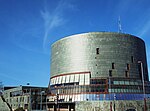Pontevedra (Galician: [ˌpontɪˈβɛðɾɐ], Spanish: [ponteˈβeðɾa] ) is a city in the autonomous community of Galicia, in northwestern Spain. It is the capital of both the Comarca and Province of Pontevedra, and the capital of the Rías Baixas. It is also the capital of its own municipality which is often considered an extension of the actual city.
The city is best known for its urban planning, pedestrianisation and the charm of its old town. Between 2013 and 2020, the city received numerous awards for its urban planning, like the international European Intermodes Urban Mobility Award in 2013, the 2014 Dubai International Best Practices Award for Sustainable Development awarded by UN-Habitat in partnership with Dubai Municipality and the Excellence Award of the center for Active Design in New York City in 2015, among others. The city also won the European Commission's first prize for urban safety in 2020.Surrounded by hills, the city is located on the edge of an estuary at the mouth of the Lérez river by the sea, at the end of the Ria de Pontevedra, in the heart of the Rías Baixas. An economic centre and tourist destination, with a population of 83,260 in 2020, it is at the head of a metropolitan area around its Ria of more than 200,000 inhabitants comprising the municipalities of Poio, Marín, Sanxenxo, Bueu, Vilaboa, Cerdedo-Cotobade, Ponte Caldelas, Barro and Soutomaior.
Pontevedra has the second most important historic center in Galicia, after Santiago de Compostela. A city of art and history, the city is known as The Good City (name attributed by the French author Jean Froissart in his Chronicles in the 14th century) or The City of the Lérez. The city is also an important stopover on the Portuguese Way path of the Camino de Santiago: the circular church of the Pilgrim Virgin has a floor plan in the shape of a scallop shell and there are scallop shells sculpted in the arches of the medieval Burgo Bridge.
Pontevedra city has an important group of squares of medieval origin and monumental religious buildings, including the Basilica of Saint Mary Major (16th century) with its plateresque Renaissance façade, the Baroque Church of the Pilgrim Virgin (18th century) with its rounded façade, the ruins of the Gothic Convent of San Domingo (13th century), the Gothic Church of San Francisco (13th century), the Baroque Church of San Bartholomew (end of the 17th century) and the Gothic Convent of Santa Clare (14th century). Its old town also contains numerous noble houses with coat of arms (the 15th century House of the Bells or the 18th century García Flórez Palace), mansions – the Mendoza Mansion, Villa Pilar – as well as old palaces such as the 18th century Mugartegui Palace, which is now the headquarters of the Rias Baixas Wine Regulatory Council, or the Counts of Maceda Palace, which is now a Parador. Another major symbol of the city is the Ravachol Parrot, whose statue is in the city centre. The city also has a marina close to its historic centre. At present, Pontevedra is a city in full revival. It has become the flagship city of the network of walkable cities and one of the cities in the world where children live best, known as The City of Children.Pontevedra is an important administrative, political, judicial, military, historical and cultural centre. In the 16th century it was the largest city in Galicia. Nowadays it is marked by a large presence of administrative services (provincial Administrative Complex and provincial branches of the central government), justice (provincial court and provincial judicial complex), political (Pontevedra provincial council, provincial government delegation), military (provincial defence delegation, BRILAT) and cultural (Pontevedra Museum, Pontevedra Auditorium and Convention Centre, Principal Theatre, faculty of Fine Arts, Afundación cultural centre, Café Moderno).












